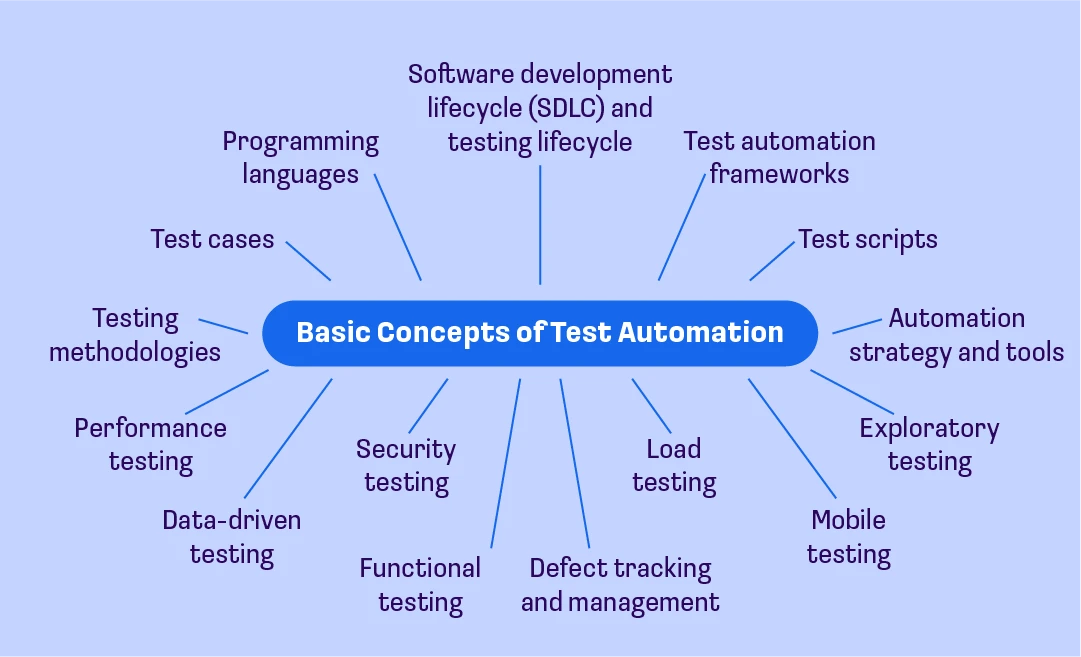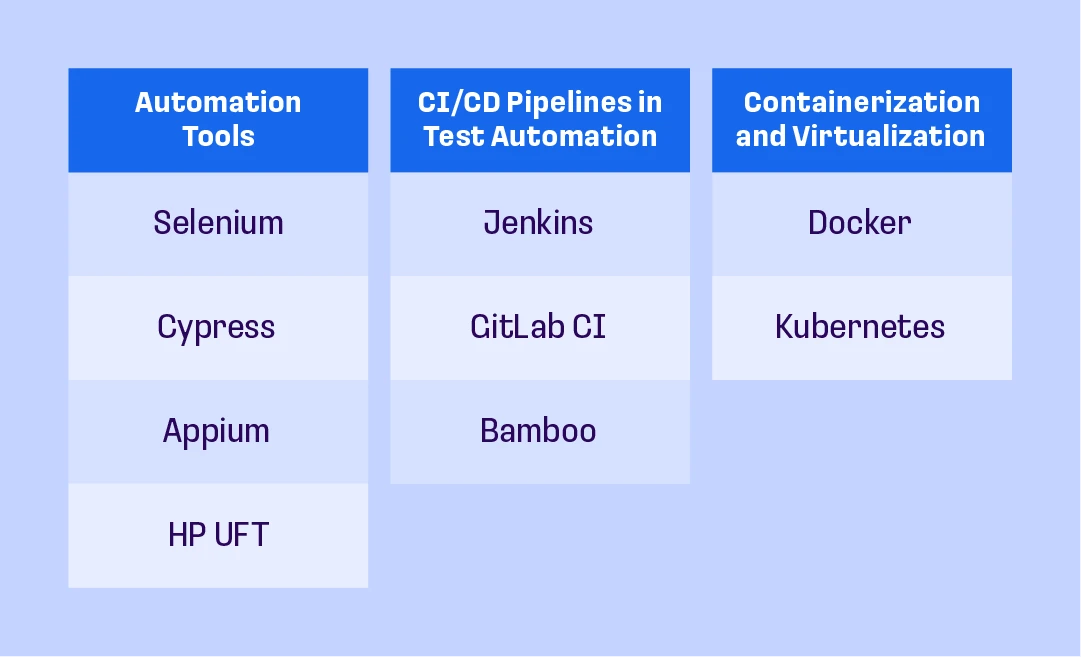Roadmap for Automation Testing: Building a Successful Career in Tech
The author of this article is tech expert Pieter Murphy.

For those interested in the QA automation career path, understanding the roadmap for automation testing is essential. By learning about the journey ahead, quality assurance professionals who previously focused on manual testing — as well as nearly any other type of QA professional — can put themselves on the path toward success.
Fortunately, the QA automation tester roadmap is reasonably straightforward. If you want to become a QA engineer, here’s what you need to know.
Basic Concepts and Terminology of Test Automation

Before you prepare to follow the QA automation engineer roadmap, it’s helpful to understand some of the core concepts and terminology. First, knowing how manual testing and automated testing differ is critical. While manual methods rely on human action, automated tests rely on automation tools that do most of the heavy lifting.
As a result, those who want to become a good automation tester — or even a great one — need to begin their journey by learning the basics. Some of the fundamental understandings required include:
- Software development lifecycle (SDLC) and testing lifecycle
- Test cases
- Test scripts
- Testing methodologies
- Automation strategy
- Automation tools
- Programming languages
- Test automation frameworks
- Performance testing
- Exploratory testing
- Data-driven testing
- Mobile testing
- Security testing
- Load testing
- Functional testing
- Defect tracking and management
Knowing what software quality means is similarly critical. Additionally, remaining open to continuous learning is essential. QA engineers don’t learn test automation once and then stop acquiring new knowledge and testing skills. Instead, they focus on constant growth, and that’s essential for anyone who wants to follow the test automation roadmap successfully.
The Place of Test Automation in the Software Development Lifecycle
Before you embark on the career path for software QA engineer positions, understanding where test automation fits into the SDLC is essential. The use of automated testing helps ensure software quality by creating opportunities to spot defects as early as possible.
In most cases, the automation testing lifecycle runs concurrently with the SDLC, particularly for test automation engineers working for companies that embrace continuous integration (CI) and continuous delivery (CD). In most cases, engineers create test cases and test scripts that fit into the development pipeline, allowing deployed code to be checked regularly for defects that need correcting. Then, companies can act swiftly as issues are identified, ensuring they're fixed as early in the process as possible.
Must-have Skills and Knowledge to Become a Test Automation Engineer
Before reviewing the automation testing roadmap, it’s critical to ensure you bring the necessary know-how to the table. Essentially, to progress in the field, you need the right skills and knowledge to move through those steps. By honing those capabilities and any required understandings, you’re laying down a strong foundation. As a result, you’ll have an easier time becoming a test automation professional.
Whether you want to transition from manual testing to automation or are starting from scratch professionally, here are the various skills and knowledge you’ll need to successfully follow the roadmap to become a test automation engineer.
Programming Languages
As with many positions relating to application development, knowing specific programming languages is a must. Which ones are critical to QA testers may vary depending on the exact nature of the role. However, specific ones provide significant value to anyone interested in the field.
Here are some of the programming languages it’s wise to learn for automation testing:
- Java
- JavaScript
- Typescript
- Python
- C#
- Ruby
Version Control
Another key knowledge area for professionals in this field is version control. Also known as source control, version control gives you the ability to track and manage changes to code throughout the development process.
With test versioning, you can maintain a historical record of all testing activities and how the related code changed as development proceeded. It essentially lets you go back in time to see what’s occurred and why it happened. Along with providing powerful insights, it also creates opportunities for rollbacks if a new version of the code proves ineffective. That can dramatically streamline the development process, ensuring that any changes aren’t necessarily permanent unless they provide the appropriate results.
Software Development and Testing Methodologies
Understanding software development and testing methodologies is a critical part of the roadmap for software testing automation. Many organizations use specific strategies to streamline development and accelerate timelines. For example, they may use DevOps, Agile, V-model, or waterfall methodologies.
Again, which ones provide professionals with the most value may depend on the positions they ultimately land. However, it’s best to familiarize yourself with all of the most widely used options, as the odds that you’ll encounter them during your career are high.
The Most Popular Tools for QA Automation Engineers
Once you start building the skills and knowledge areas above, it’s time to focus on QA automation tools you’ll probably need to leverage once you land a position. Tools like Selenium, Jenkins, Docker, and many others are fundamental to the field, as they provide QA testing engineers with the capabilities they need to handle their duties.
Here is a breakdown of some of the most popular tools for quality assurance automation engineers.

Automation Tools
Selenium
For web applications, Selenium is a go-to option for aspiring automation engineers and QA professionals looking to embrace automation. It’s an open-source testing tool that works across a variety of browsers, and it’s easy to use as long as you are familiar with JavaScript.
Cypress
Cypress is another web-oriented option, and it’s becoming more popular over time. It’s an end-to-end tool based on JavaScript, making it user-friendly and highly capable for automated web testing.
Appium
Appium offers reliable automation tools for mobile application testing. It’s an open-source framework that works on different types of mobile platforms, including Android and iOS. Appium is essentially a must for anyone who wants to become a QA tester with a focus on mobile.
HP UFT (formerly QTP)
HP UFT is an automated functional testing tool that’s based on the Visual Basic programming language. Along with working on web applications, HP UFT is also an excellent option for desktop application automated testing.
CI/CD Pipelines in Test Automation
Jenkins
Jenkins is an open-source CI server that’s commonly part of the CI/CD pipeline. It provides professionals with tools to help build, test, and deploy code continuously and automatically. As part of a broader solution, it can even automate end-to-end (E2E) testing.
GitLab CI
GitLab is another solution for automating builds, tests, and code deployment. It has an incredibly broad feature set, allowing teams to access a variety of capabilities in a single platform. Auto-scaling runners, merge trains, container registries, test coverage visualization, and much more are available through GitLab CI.
Bamboo
Bamboo is an open-source CI server focused on the building, testing, and deployment of web applications. It offers a user-friendly interface and a variety of features designed to streamline development and create seamless, intuitive workflows for Agile environments.
Containerization and Virtualization
Docker
Docker is a software application that’s incredibly popular with quality assurance professionals and organizations looking to streamline development. Its containerization features allow teams to use an image on different platforms without having to adjust much to align with the operating system (OS). Since the containers are reusable and reproducible, it’s also a solid choice for destructive testing.
Kubernetes
Offering scaling, management, and deployment capabilities, Kubernetes is a container orchestration tool that’s highly popular in the world of test automation. Container management tasks can be automated, and it has commands built-in to roll out changes, handle deployments, and scale applications up or down as needed.
Step-by-step Roadmap for Becoming a Software Testing Automation Engineer
Now that you understand the necessary skills and core competencies to start on this career path, it’s time to take a closer look at the complete test automation engineer roadmap. The basic roadmap for becoming a software testing automation engineer contains the following steps:
- Write Test Cases
- Data-driven and Keyword-driven Testing
- Implementing Automated Testing in CI/CD
- Mobile and Cross-browser Testing
- API and Performance Testing
- AI and Machine Learning in Test Automation
- Test Automation in Cloud Environments
The steps serve as a functional guide, allowing you to explore the right areas to hone your capabilities and prepare for a career in automated testing.
In many cases, this part of the journey can unfold in a few ways. You can use a self-directed approach if you want to prepare for your career on your own. Alternatively, if you’re currently employed in a similar field, you can seize opportunities in your workplace to grow and develop in the right direction.
Here is a closer look at the steps you’ll need to follow to become a software testing automation engineer.
Step 1. Write Test Cases
The first step on the automation test roadmap is to write test cases. Often, they’re the foundation of automation testing, so learning how to write scalable, reusable, and maintainable scripts serves as an excellent starting point.
In most cases, you’ll want to begin by creating highly simple test cases. Then, you can make them more complex as you hone your skills and achieve some success. By using the gradual approach, it also ensures you’re not overwhelmed. Plus, it creates opportunities to focus on the fundamentals initially, allowing you to build a strong base.
Step 2. Data-driven and Keyword-driven Testing
Data-driven testing (DDT) and keyword-driven testing (KDT) are two of the core test automation frameworks used by QA engineers. With DDT, you can automate the creation, management, and use of input data on a near-limitless scale. KDT involves automating tests based on series of operations which are initialized by keywords, essentially simulating typical end user’s actions like keystrokes or mouse clicks.
Both DDT and KDT are widely used and highly valuable. As a result, familiarizing yourself with both is typically the best choice. As with writing test cases, start simple and build up complexity as your skills grow, allowing your journey to unfold as comfortably as possible.
Step 3. Implementing Automated Testing in CI/CD
Another critical step in the QA automation roadmap is to understand how to implement automated testing in CI/CD environments. Along with understanding the primary concepts and reasonings behind CI/CD, you need to learn the various tools and skills that support CI/CD.
Step 4. Mobile and Cross-browser Testing
With mobile and web development, one goal many organizations share is to ensure the application runs on multiple devices or browsers. For mobile, learning how to make sure an app will operate on popular platforms – particularly Android and iOS – is an excellent starting point. Familiarizing yourself with mobile application testing tools like Appium is similarly wise, as they can streamline the process.
For web, understanding the nuances of widely used browsers like Google Chrome, Windows Edge, and Mozilla Firefox provides you with the right foundation. Then, you can learn applicable automation testing tools, such as Selenium and Cypress. That way, you have the right knowledge and skills to keep moving forward.
Step 5. API and Performance Testing
At this point in the roadmap for QA automation professionals, it’s time to move on to API and performance testing. With APIs, learning how to automate tests and validate responses is a critical part of the equation.
For performance testing, understanding how to use various tools to test loads is similarly vital. Additionally, you’ll want to explore the worlds of scalability and stress testing, allowing you to examine how a system responds under a variety of scenarios.
Step 6. AI and Machine Learning in Test Automation
Artificial intelligence (AI) and machine learning (ML) are bringing new capabilities to the test automation landscape. They can help analyze data to identify patterns, create test cases automatically, improve test efficiency, and much more.
Generally, AI and ML in automation testing are relatively new. However, organizations are increasingly seeking professionals with these skills. As a result, honing capabilities related to AI and ML can separate you from the pack, making it easier to find lucrative opportunities in the field. Plus, it can provide you with career stability. Since AI and ML will likely remain part of the equation for the foreseeable future, capabilities relating to them could be the key to long-term job security.
Step 7. Test Automation in Cloud Environments
The final part of the automation QA roadmap is to incorporate cloud environments into the equation. Many QA platforms are cloud-based solutions, so understanding how they work is beneficial. Additionally, cloud application development is on the rise, causing organizations to view professionals with cloud-related skills and experience more favorably than those who aren’t as familiar.
Cloud solutions are also widely used for collaboration and project management, particularly by organizations that use remote teams. Again, this makes different types of cloud skills valuable. For example, knowing how to leverage cloud-based communication and collaboration platforms typically works in your favor, so keep that in mind.
Career Path and Growth of QA Automation Engineers
Now that you’ve reviewed the roadmap to automation testing for professionals, it’s time to understand why the journey is worth making. Currently, professionals with QA automation skills are in demand. As a result, moving up in the field is relatively straightforward and is potentially simpler than it is in fields with more competition.
While every QA career is unique, there are specific roles that professionals commonly hold along the way. Many begin in a manual testing position, as that is an excellent place to hone various fundamentals. However, for those with the right skills and knowledge, that isn’t always necessary.
Usually, the first role in the field professionals hold is a junior automation engineer position. These are functionally entry-level roles, so they require the least amount of previous experience. The job provides opportunities to add tests based on existing building blocks instead of writing from scratch, making them excellent ways to build a foundation.
Next, it’s time for a mid-level position. There are several roles that fall into this category, including test automation developer, test automation engineer, quality engineer, and others. At this level, writing test cases is more common, as well as playing a bigger part in the SDLC.
After that, it’s senior-level roles. Usually, these professionals build test automation projects from the ground up. Additionally, they may function as a team’s supervisor, giving them oversight over more junior QA professionals. Often, senior-level engineers progress into the position of automation architect or become formal team leads or managers, depending on whether they want to focus on remaining an individual contributor or transition into the world of management.
Summary
Ultimately, the information above effectively covers the complete roadmap on how to become a QA automation engineer. Whether you’re currently a QA professional or are preparing to launch your first career, by using it as a guideline, you can get moving in the right direction.
Join the following courses to learn more:
- Python automation training for testers.
- GenAI adoption training for test automation engineers (for corporate teams or independent groups).
- GenAI adoption training for software testing engineers (for corporate teams or independent groups).


.png)
